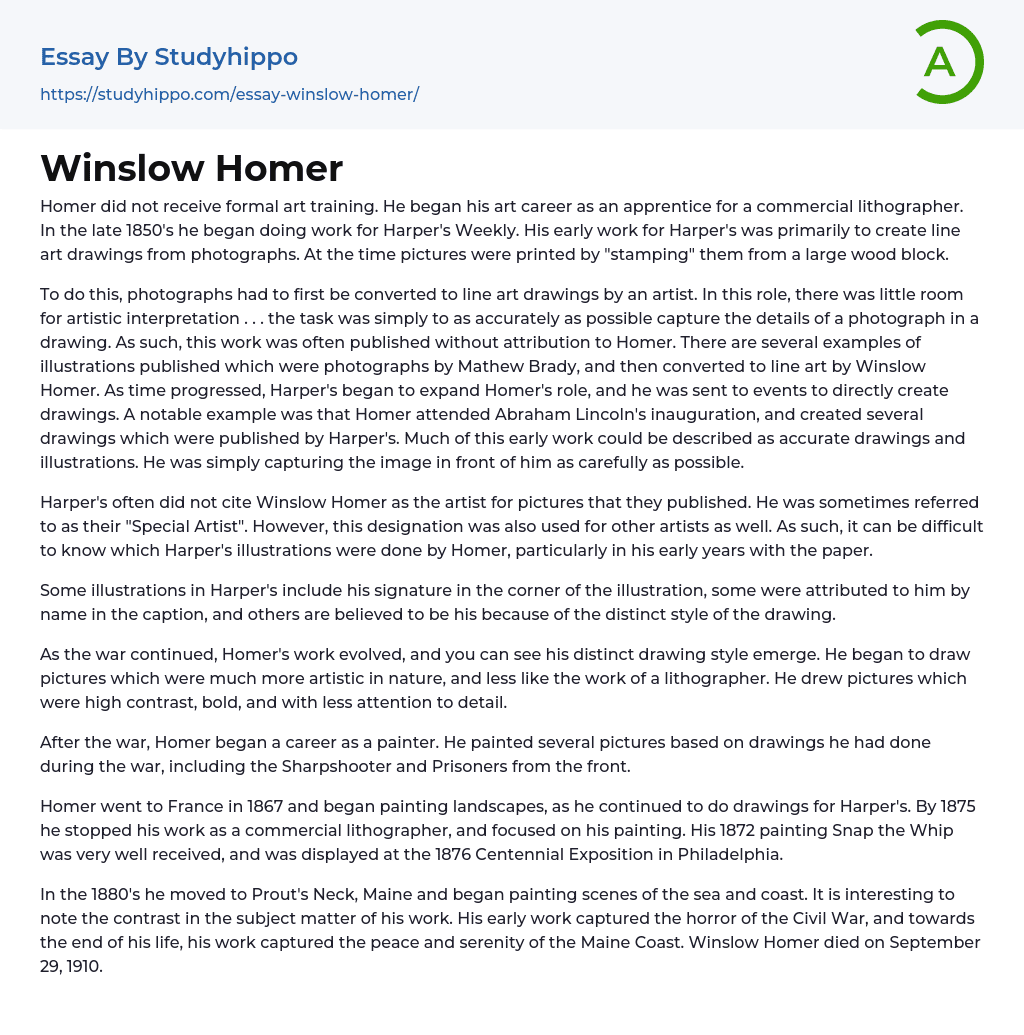Homer did not receive formal art training. He began his art career as an apprentice for a commercial lithographer. In the late 1850's he began doing work for Harper's Weekly. His early work for Harper's was primarily to create line art drawings from photographs. At the time pictures were printed by "stamping" them from a large wood block.
To do this, photographs had to first be converted to line art drawings by an artist. In this role, there was little room for artistic interpretation . . . the task was simply to as accurately as possible capture the details of a photograph in a drawing. As such, this work was often published without attribution to Homer. There are several examples of illustrations published which were photographs by Mathew Brady, and then converted to line art by Winslow Homer. As time progressed, Harper's bega
...n to expand Homer's role, and he was sent to events to directly create drawings. A notable example was that Homer attended Abraham Lincoln's inauguration, and created several drawings which were published by Harper's. Much of this early work could be described as accurate drawings and illustrations. He was simply capturing the image in front of him as carefully as possible.
Harper's often did not cite Winslow Homer as the artist for pictures that they published. He was sometimes referred to as their "Special Artist". However, this designation was also used for other artists as well. As such, it can be difficult to know which Harper's illustrations were done by Homer, particularly in his early years with the paper.
Some illustrations in Harper's include his signature in the corner of the illustration, some were attributed to
him by name in the caption, and others are believed to be his because of the distinct style of the drawing.
As the war continued, Homer's work evolved, and you can see his distinct drawing style emerge. He began to draw pictures which were much more artistic in nature, and less like the work of a lithographer. He drew pictures which were high contrast, bold, and with less attention to detail.
After the war, Homer began a career as a painter. He painted several pictures based on drawings he had done during the war, including the Sharpshooter and Prisoners from the front.
Homer went to France in 1867 and began painting landscapes, as he continued to do drawings for Harper's. By 1875 he stopped his work as a commercial lithographer, and focused on his painting. His 1872 painting Snap the Whip was very well received, and was displayed at the 1876 Centennial Exposition in Philadelphia.
In the 1880's he moved to Prout's Neck, Maine and began painting scenes of the sea and coast. It is interesting to note the contrast in the subject matter of his work. His early work captured the horror of the Civil War, and towards the end of his life, his work captured the peace and serenity of the Maine Coast. Winslow Homer died on September 29, 1910.
- Design essays
- Graffiti essays
- Graphic essays
- Typography essays
- Painting essays
- Photography essays
- Sculpture essays
- Architecture essays
- Interior design essays
- Arch essays
- Area essays
- Aesthetics essays
- Art History essays
- Artist essays
- ballet essays
- Body Art essays
- Color essays
- Concert Review essays
- Creativity essays
- Cultural Anthropology essays
- Ethnography essays
- Harlem Renaissance essays
- Heritage essays
- Modernism essays
- Mona Lisa essays
- Pastoral essays
- Postmodernism essays
- Realism essays
- Symbolism essays
- Theatre essays
- Visual Arts essays
- Voice essays
- Work of art essays
- Aldous Huxley essays
- Alice Walker essays
- Amy tan essays
- Anne Bradstreet essays
- Anton Chekhov essays
- Arthur Miller essays
- Augustine essays
- Bertolt Brecht essays
- Booker T Washington essays
- Carol ann duffy essays
- Charles Dickens essays
- Charlotte Perkins Gilman essays
- Chinua Achebe essays
- Christina Rossetti essays
- Consider The Lobster essays
- Edgar Allan Poe essays
- Elizabeth Bishop essays




